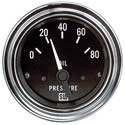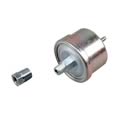- Joined
- Apr 15, 2008
- Messages
- 13,731
- Location
- California Delta
- Vessel Name
- FlyWright
- Vessel Make
- 1977 Marshall Californian 34 LRC
My 1977 Californian still has what I believe are the original mechanical oil pressure gauges with capillary tubes carrying oil to the gauges. I've been waiting for one of these to fail...and now one of the gauges has started a very slow leak at the lower helm. I ordered new Stewart Warner electric Oil Ps gauges and sending units yesterday from Summit Racing with free shipping and they arrived this afternoon! Looks like I've got to install them now.
My plan is to do the lower helm gauges now and update the FB gauges this summer. I do not have an engine alarm system, so it shouldn't create a problem there. I realize that will leave my FB gauges inop, but I can live with that for a few months as I normally drive from the lower helm and will have plenty of time onboard this summer for projects like this.
Has anyone already tackled this project? Any caveats or issues to watch out for? The sending units didn't come with instructions, but I assume I shouldn't insulate the sender mounting threads from the engine block to allow electrical conductivity.


My plan is to do the lower helm gauges now and update the FB gauges this summer. I do not have an engine alarm system, so it shouldn't create a problem there. I realize that will leave my FB gauges inop, but I can live with that for a few months as I normally drive from the lower helm and will have plenty of time onboard this summer for projects like this.
Has anyone already tackled this project? Any caveats or issues to watch out for? The sending units didn't come with instructions, but I assume I shouldn't insulate the sender mounting threads from the engine block to allow electrical conductivity.


